Truffle Hunt: clauses
What is the Clauses mode?
Truffle Hunt's Clauses mode enables you to search through thousands of extracted clauses from hundreds or thousands of old documents, to quickly find a relevant clause. ClauseBuddy will then search through those files and extract fragments of text that seem relevant. You can then quickly search through all extracted clauses, in search of good clauses.
Why would I want to use it?
The biggest advantage of Truffle Hunt's clauses mode is that it requires almost no effort to build a collection of clauses: simply upload documents once, and have everything processed automatically for you. This is extremely tempting for busy legal teams, who are always pressed for time, yet still want to benefit from low-hanging tech fruit.
Using this mode is ideal when you know exactly what you are searching for, and you do not need any surrounding context to assess the merits of a clause. If those circumstances apply, then it will allow you to retrieve clauses quicker than extracting clauses from the Document mode, or curating a Quality Library of clauses.
You should be aware, however, that there are tradeoffs:
You will save time upfront, but pay later with each and every search. For a typical legal team, the time spent on a day-to-day basis will exceed the time spent on curating a Quality Library.
Legal quality will suffer, because clauses are extracted from their context. Quality clause libraries simply offer much better guidance, particularly towards young team members.
Due to the sheer volume of clauses extracted, you may run into compliance issues. If you are like most legal experts, you are subject to client confidentiality rules, non-disclosure obligations, data protection rules and various internal security rules. No matter how secure ClauseBuddy is, storing thousands of confidential on external systems for mere efficiency reasons, is usually a bad idea.
Understanding the clause extraction process
ClauseBuddy automatically extracts clauses from your uploaded documents. This requires zero effort from your side — just a little bit of patience, about 1.5 seconds per document if you have a good internet connection.
However, you should be aware that automatic extraction is hit-and-miss process. For example, have a look at the clause below. Assuming you think it is wonderfully written and you want to include it in your clause library, how would you deal with it? Keep it as a whole and insert it as-is, because that’s the nature of such a “miscellaneous” clause? Or store each of the individual paragraphs? Or perhaps store both?
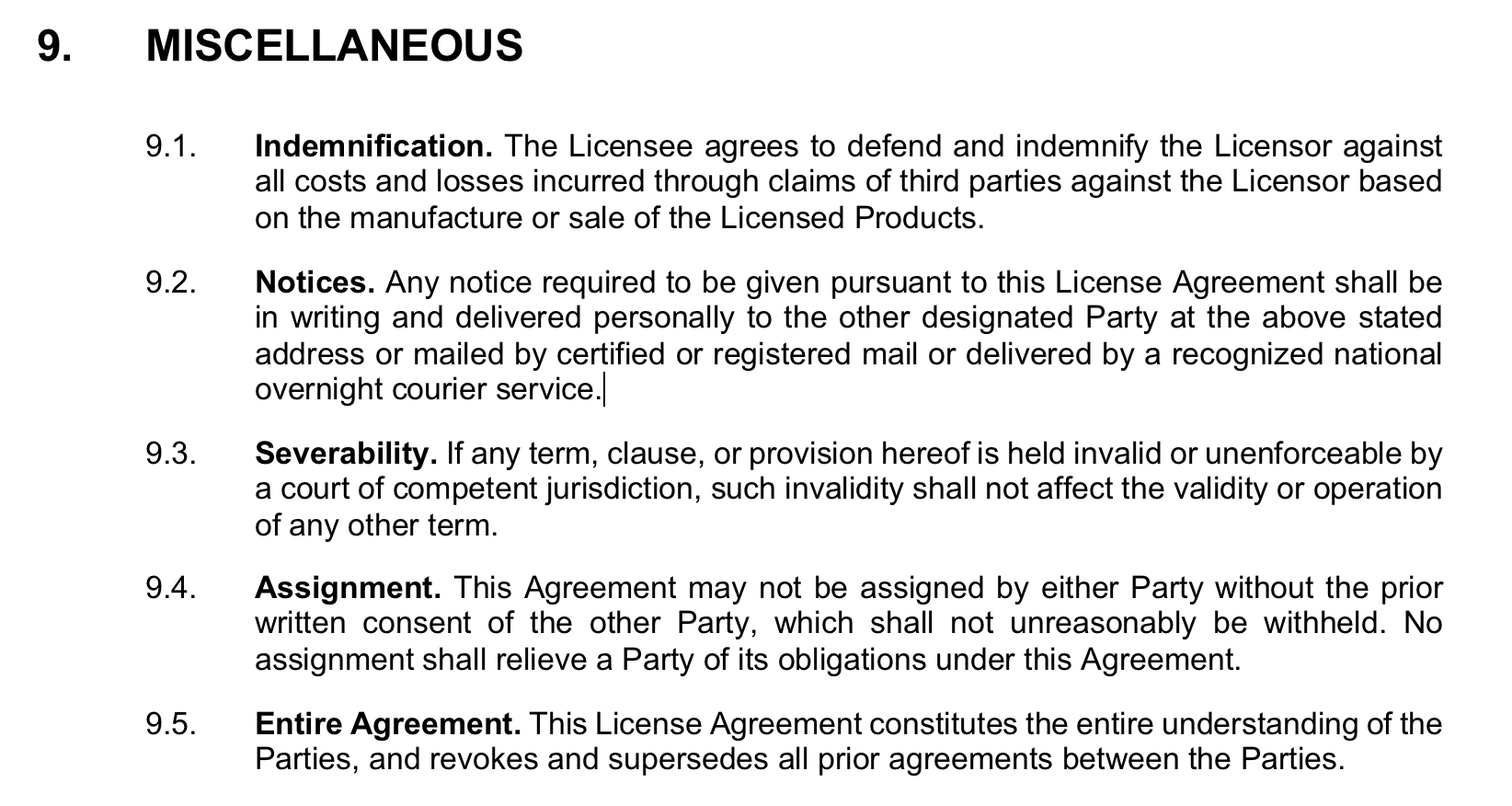
ClauseBuddy uses advanced algorithms and some fast artificial intelligence (not GPT) to extract only relevant content, and split the content in a reasonable way. But do not expect this to be perfect: there will be many situations where you would make a different splitting assessment, erroneously considers text to qualify as a title, or where the software inadvertently ignores certain paragraphs, or instead extracts irrelevant paragraphs.
While we continue improving the extraction process, this is simply the tradeoff of having everything extracted automatically, as opposed to manual clause curation. The quality of the extraction will depend on the type of document (the software is trained on contracts), the language, the formatting (automatically formatted documents work much better), and so on.
User interface for searching
Getting started with Truffle Hunt's search mode is quite easy, but there are actually quite some additional search tools that you may want to read about.

The Basket Selection allows you to select different baskets to search in.
The Definition checkbox allows you to limit searches to clauses that were identified as definitions inside a contract.
The Strict Search checkbox allows you to search for content in a more literal way.
The Undo/Redo buttons allow you to go back and forth in your search actions.
The Switch Buttons allow you to transfer your query to other search modules (when available): keyword search in your Quality Library, or Samples Hunt.
In the Primary Query box you type words that should be present in your clause. If you checked "Definition", then this box will instead allow you to search for the legal term. In the Secondary Query box — not currently shown, it is only visible when searching for definitions — you type words that must also be present in the definition's body text.
In the Filter panel you can narrow down found documents to certain categories, authors, years, files or titles.
The Words slider allows you to filter clauses by their length.
The Add to Quality Library button allows you to store a clause in your Quality Library.
The Send to Curator button allows you to send a clause to a curator in your team.
the Redraft button allows you to redraft clauses using artificial intelligence.
The Insert/Copy button allows you to insert the clause into your Word-document, or (when used outside MS Word) to copy the clause to the clipboard.
Title of the clause
Information regarding the document from which this clause was extracted. When you click on this bar, you will be taken to the entire document.
The Language selection dropdown list
1. Basket Selection
Truffle Hunt allows you to create different "baskets" with clauses — e.g., one for the Corporate department, one for Employment, one for IT/IP, and perhaps also a personal basket for every legal expert.
When you switch between baskets, Truffle Hunt will re-submit your current search query. So if you do not find any useful results in one basket, you can easily try in another basket to which you have access.
2. Definition
When checked, the Primary Query box will be used to search for the legal term, and the Secondary Query box will be used to search for words in the body of the definition. See the explanation below.
3. Strict search
ClauseBuddy allows you to search in two modes: smart and strict.
The default search mode is smart. In this mode, ClauseBuddy uses an intelligence layer to search for clauses that semantically match what you type in. The search will not be literal, so that descriptions and synonyms will usually also result in the right clause being shown at the top.
You can also search in strict mode, by enabling the checkbox to the right of the search box. In strict mode, the search is performed in a literal way. Even though grammatical variations are allowed (e.g., searching for "claims" will also find clauses containing the singular "claim"), clauses that contain synonyms of your keywords will not be included in the search results.
4. Undo/redo buttons
With these buttons, you can go back & forth in your list of historical actions. So if you liked your initial search, but then made a few changes that were not so smart after all, you can go back to your initial search by hitting the Undo button a few times.
5. Jump to other search modules
By pressing this button, you can easily switch to the other search modules in ClauseBuddy. For example, when you are searching for a clause on "assignment" in a corporate context, but you suddenly realise that it's perhaps better to search within your Quality Library, you can click on the magnifying glass to jump to the keyword search within the Quality Library. Your current search term ("assignment") will then automatically get filled in and search on.
6. Query boxes
In the primary query box (left) you type in your main search terms. Truffle Hunt will then search for clauses where those terms are found in either the title or the body of the clause. Truffle Hunt will also take into account grammatical variations, depending on the language in which you are searching.
Searching for a definition
If you have enabled the "Definition" checkbox, then the primary query converts into a defined term selector. If you want to narrow down the body of definitions, then you should enter search terms in the Secondary Query box.
For example, in the screenshot below, you can see a search for a definition of the term "material adverse change", narrowed down to definitions whose body also contains the word "merger"
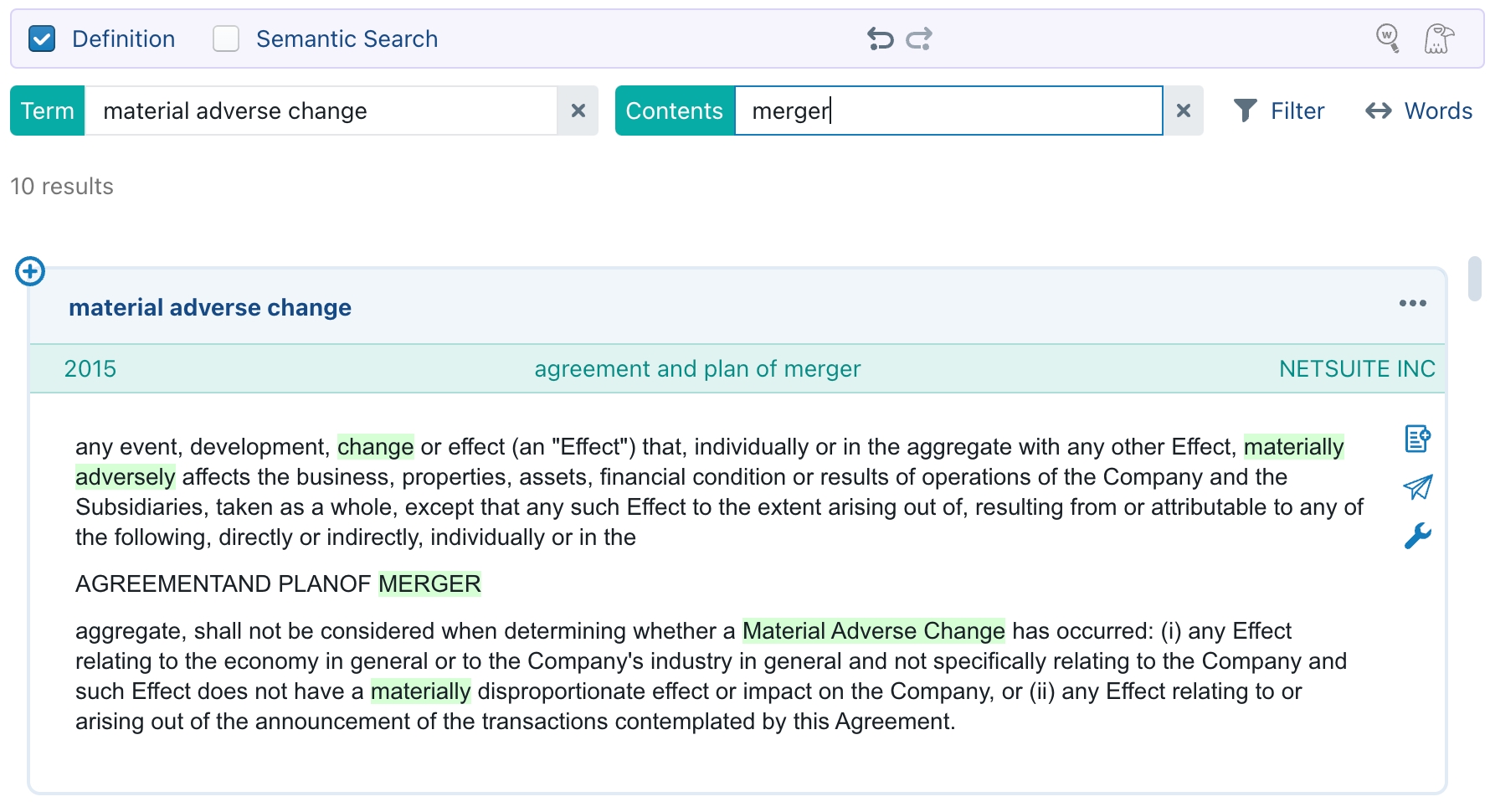
Literal search
Similar to searching in Google, you can quote search terms, to ensure that terms are not merely present within the clause, but are instead found next to each other.
For example, when you want to search for licensor's liability, you will notice that the software will also find clauses in which both words are separated from each other.
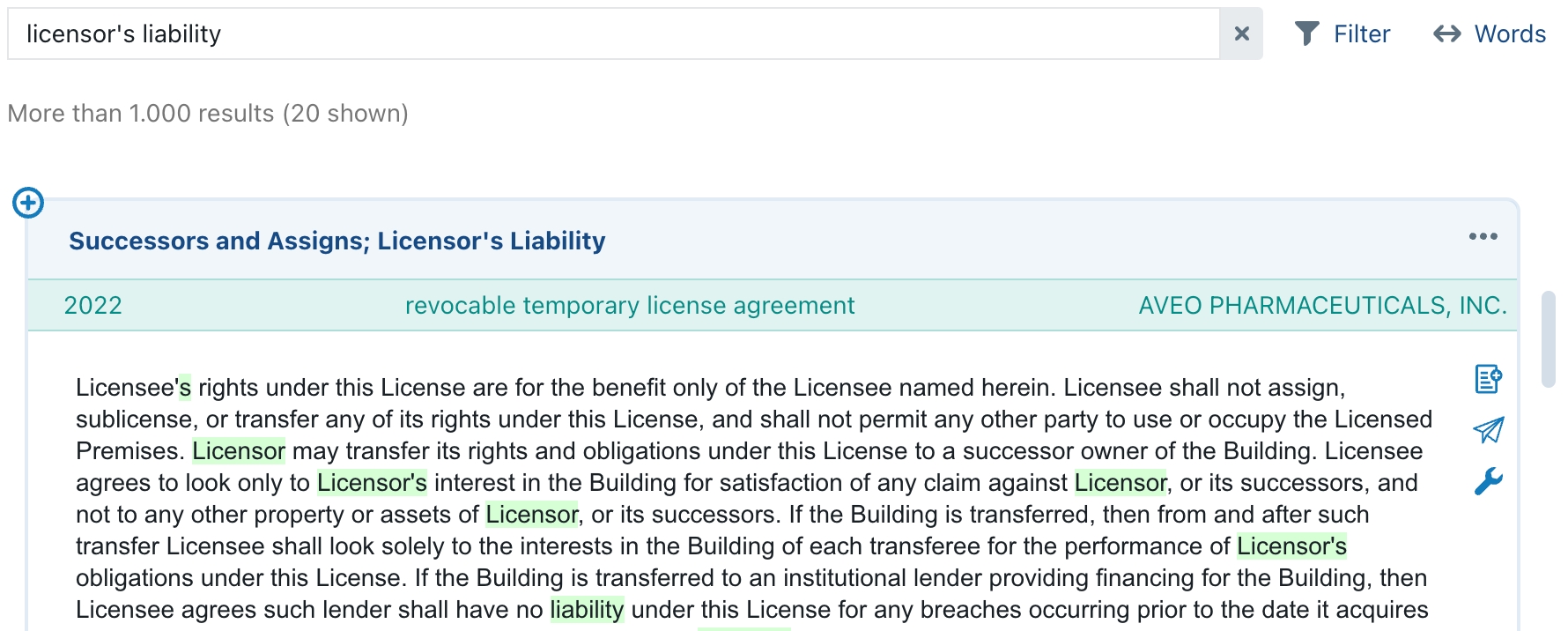
If you instead put double quotes around the words, only clauses that will contain both words next to each other will show in the search results.
Removing terms
By adding a hyphen to a term, you will remove search results having that term near the other terms specified. For example, this will search for clauses with the expression garden leave, but without the word executive.

Secondary Query
In this box, you can specify other words that need to be present in the definition's body. See explanation above.
7. Filter Panel
In this panel you can filter found results on criteria such as the document's title, year, author, client or dossier name.
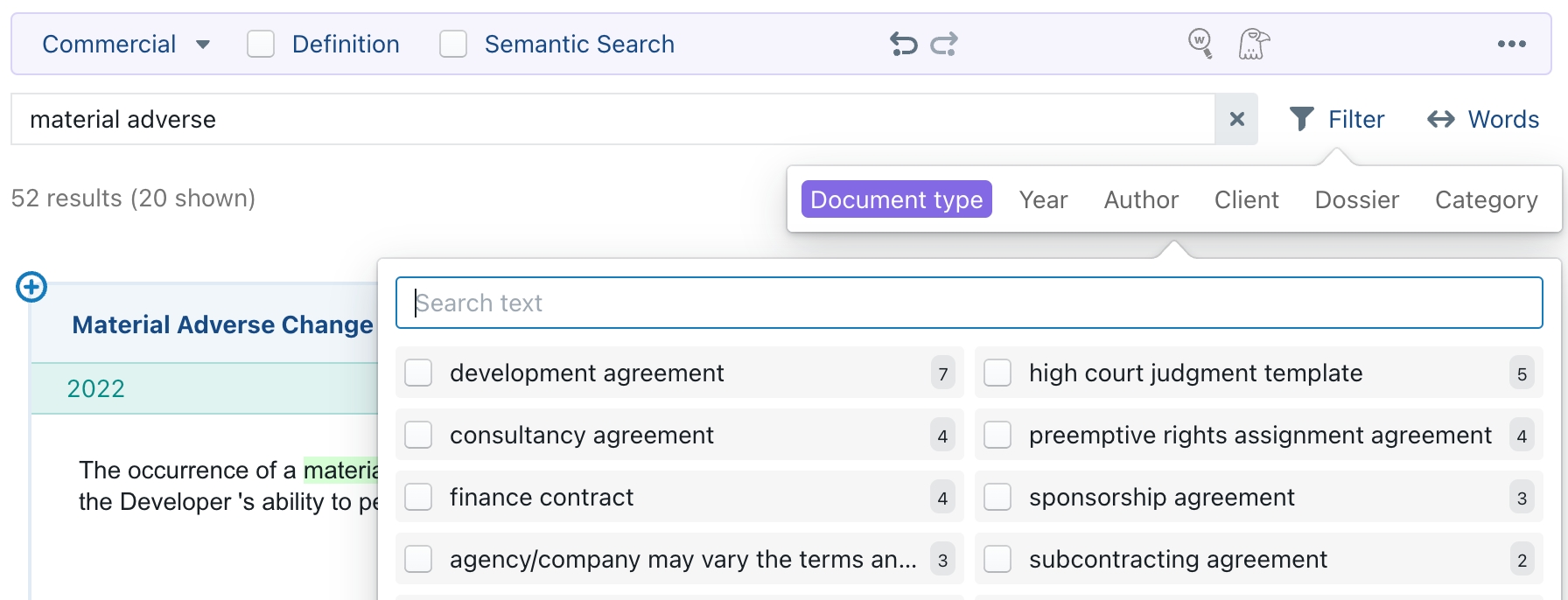
The numbers to the right of each result in the popup dialog indicate how many unique clauses match this filter, taking into account all the other filters and criteria. For example, in the screenshot above, 8 unique clauses with the words "material" and "adverse" were found in documents entitled "development agreement". If other criteria would have been specified as well (e.g., the clause length, or the year, ...) then those would also have been taken into account when determining the number to the right.
8. Words slider
This slider allows you to filter on the number of unique non-stopwords in a clause — essentially it allows you to filter on the length of clauses. For example, in the screenshot below, only very short clauses that contain the words "material" and "adverse" will be found.
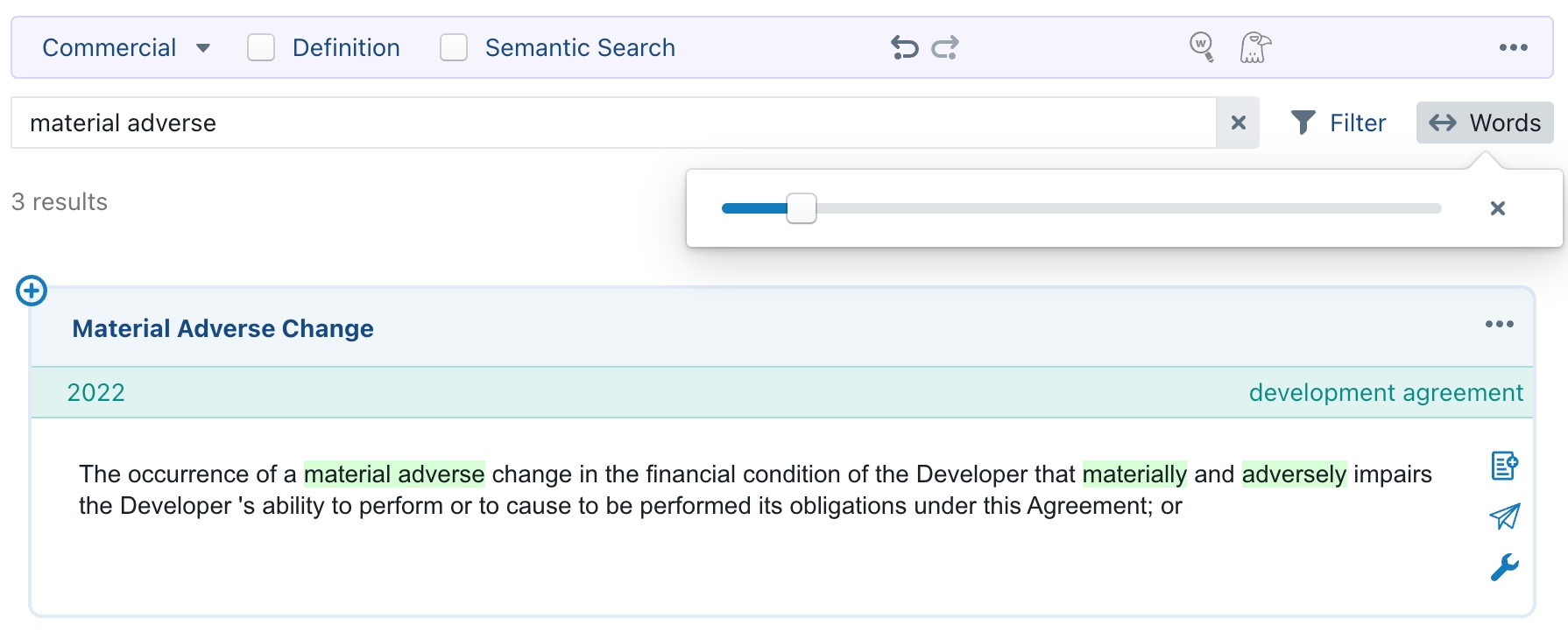
9. Add to Quality Library button
 This button extracts the title and boy of the clause, and inserts it into the Add clause dialog box.
This button extracts the title and boy of the clause, and inserts it into the Add clause dialog box.
10. Send to curator
 This button allows you to send the title and body of the clause to your curator, who will then decide whether (and how) to add it to your team's library.
This button allows you to send the title and body of the clause to your curator, who will then decide whether (and how) to add it to your team's library.
11. Redraft
 This button allows you to have artificial intelligence redraft the contents of your clause (e.g. to make it shorter or longer, or to synchronize the terminology with the terminology of the document), through a simple prompt. Afterwards, you can then request a comparison between the original text and the new text.
This button allows you to have artificial intelligence redraft the contents of your clause (e.g. to make it shorter or longer, or to synchronize the terminology with the terminology of the document), through a simple prompt. Afterwards, you can then request a comparison between the original text and the new text.
12. Insert / copy button
 This button allows you to insert the clause into your Word-document, or (when used outside MS Word) to copy the clause to the clipboard.
This button allows you to insert the clause into your Word-document, or (when used outside MS Word) to copy the clause to the clipboard.
When inserting into a Word-document, you can opt to insert the change using "track changes". Click on the name of the author ("ClauseBase Admin" in the screenshot below) to swap it to some author.

You can also change the layout of the clause, e.g. to avoid inserting the title or avoid bullets. See our separate page on inserting clauses.
ClauseBuddy is layout-aware and will usually be smart enough to match the styling of your current document. However, there is an (advanced) possibility to implement your own house style, if you want to offer more guidance towards the software on how to format certain elements. Check out the page on Custom styling for the Clause Library, which uses the same mechanism.
15. Language selection
When multiple languages are enabled, you will see the language selection dropdown box. This will determine the language of the clauses in your search results.
Search tips
General Tips
You can quote keywords if you want the keywords to appear next to each other. For example, "holiday entitlement" will only find clauses that contain the word holiday and the word entitlement (or linguistic variations of those words) next to each other.
You can insert a hyphen before a keyword to remove clauses containing that keyword from the search results. For example, when you want to find clauses containing the words "holiday" and "entitlement" but not the word "termination", you can enter holiday entitlement -termination in the search box.
Tips for smart mode
Smart mode works best if you submit several keywords at once (e.g. confidential information exclusions), or even a short description (e.g. liability limitation with a maximum equal to the invoiced amount). Similar to how you would confuse humans when only giving one word (e.g. confidentiality), smart mode does not work so well if you provide only one word.
Smart mode is relatively smart: it is a lot smarter than the strict search (which uses literal matching), but it deliberately does not use "GenAI" Artificial Intelligence to filter your results. Accordingly, expect it to be smarter than strict search, but at the same type not human-like smart. If you don't like the results results and want deeper intelligence applied, you must use the brain-like
 button, as discussed separately.
button, as discussed separately.If multiple languages are enabled then, even though the results will be in the language you selected in the dropdown list, you can use keywords in any language you want. For example, by searching for "responsable du traitement" in French, while having English selected, you will find English clauses relating to privacy.

Tips for strict mode
In strict mode, you can combine multiple keywords to narrow down your search. For example, if you are searching for employment clauses and enter holiday entitlement, ClauseBuddy will find clauses that contain both the word holiday and the word entitlement (or linguistic variations of those words). Note that both words do not need to be next to each other in the clause, in order to be found.
ClauseBuddy will ignore stop words, i.e. keywords that have no information value — e.g. words such as the, that, if, and so on (depending on the language).
Note on the number of results
It may be the case that the total number of results is less than the initial result, particularly when there are many (e.g., more than 100) results. You may therefore end up in a situation where the software will, for example, initially indicate that there are about 156 results, until you load all results by repeatedly clicking on the "Load More" button and you end up with 142 results.
Exporting search results
If you would like to export the results of any particular clause search to either a Word or Excel document, click the ... button toward the right of the toolbar and select 'Export truffles'.
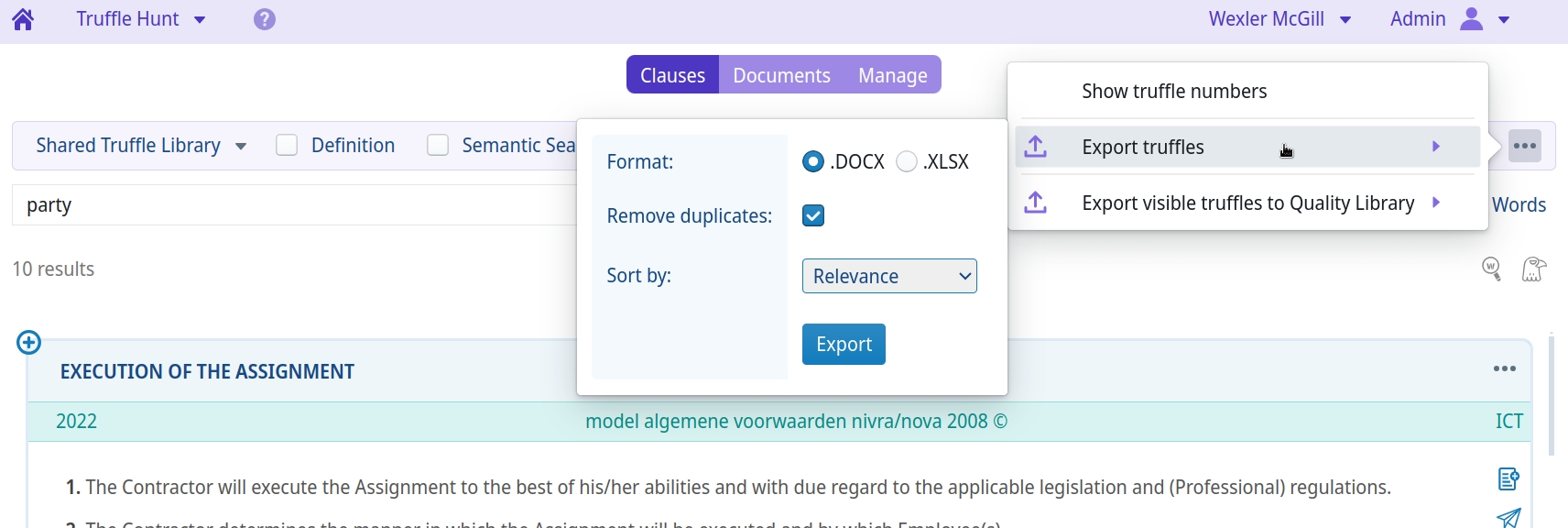
Once you have made your selection of export options and clicked 'Export', a file download link will be prepared for you. Wait a couple seconds for it to appear then click to download the file.

Last updated